lights YAMAHA GRIZZLY 700 2022 Owners Manual
[x] Cancel search | Manufacturer: YAMAHA, Model Year: 2022, Model line: GRIZZLY 700, Model: YAMAHA GRIZZLY 700 2022Pages: 176, PDF Size: 4.75 MB
Page 8 of 176

EBU17421
TABLE OF CONTENTS
VEHICLE IDENTIFICATION ............................ 1-1Identification numbers ................................ 1-1
LOCATION OF THE WARNING AND
SPECIFICATION LABELS .............................. 2-1
SAFETY INFORMATION ................................ 3-1
DESCRIPTION................................................ 4-1 Left view ...................................................... 4-1
Right view.................................................... 4-1
Controls and instruments............................ 4-2
INSTRUMENT AND CONTROL
FUNCTIONS ................................................... 5-1 Main switch ................................................. 5-1
Indicator lights and warning lights .............. 5-2
Multi-function display ................................. 5-5
Handlebar switches .................................. 5-11
Throttle lever ............................................. 5-16
Speed limiter ............................................. 5-16
Front brake lever ....................................... 5-17
Brake pedal and rear brake lever .............. 5-17
Drive select lever ....................................... 5-18 Fuel tank cap ............................................ 5-19
Fuel ........................................................... 5-20
Seat .......................................................... 5-21
Storage compartments ............................. 5-22
Front carrier .............................................. 5-26
Rear carrier ............................................... 5-26
Front and rear shock absorbers .............. 5-26
Winch ....................................................... 5-28
Trailer hitch .............................................. 5-28
Auxiliary DC jack....................................... 5-29
PRE-OPERATION CHECKS .......................... 6-1 Fuel ............................................................. 6-4
Engine oil .................................................... 6-4
Final gear oil ............................................... 6-4
Differential gear oil ...................................... 6-4
Coolant ....................................................... 6-4
Front and rear brakes ................................. 6-4
Throttle lever ............................................... 6-5
Tires ............................................................ 6-5
Chassis fasteners ....................................... 6-8
Instruments, lights and switches ................ 6-8UBLT60E0.book Page 1 Tuesday, July 13, 2021 9:16 AM
Page 24 of 176

3-3
3technique described in this manual on level
ground. Avoid crossing the side of a steep hill if
possible.
Always use proper procedures if you stall or roll
backwards when climbing a hill. To avoid stall-
ing, use the proper gear range and maintain a
steady speed when climbing a hill. If you stall or
roll backwards, follow the special procedure for
braking described in this manual. Dismount on
the uphill side or to a side if pointed straight up-
hill. Turn the ATV around and remount, following
the procedure described in this manual.
Always check for obstacles before operating in
a new area.
Never attempt to operate over large obstacles,
such as large rocks or fallen trees. Always follow
proper procedures when operating over obsta-
cles as described in this manual.
Always be careful when skidding or sliding.
Learn to safely control skidding or sliding by
practicing at low speeds and on level, smooth
terrain. On extremely slippery surfaces, such as
ice, go slowly and be very cautious in order to
reduce the chance of skidding or sliding out of
control.
Never operate an ATV in fast flowing water or in
water deeper than that recommended in this
manual. Remember that wet brakes may have
reduced stopping ability. Test your brakes after
leaving water. If necessary, apply them several
times to let friction dry out the linings.
Always be sure there are no obstacles or people
behind you when you operate in reverse. When
it is safe to proceed in reverse, go slowly.
Always use the size and type of tires specified in
this manual.
Always maintain proper tire pressure as de-
scribed in this manual.
Never exceed the stated load capacity for an
ATV. Cargo should be properly distributed and
securely attached. Reduce speed and follow in-
structions in this manual for carrying cargo or
pulling a trailer. Allow greater distance for brak-
ing.
Do not operate your ATV during darkness un-
less it is equipped with a properly functioning
headlight. Off-road riding is inherently danger-
ous and additionally, off-road trails do not have
streetlights to guide you.
UBLT60E0.book Page 3 Tuesday, July 13, 2021 9:16 AM
Page 25 of 176

3-4
3
Never maintain an ATV without proper knowl-
edge. Contact an authorized ATV dealer to in-
form you on basic ATV maintenance. Certain
maintenance can only be carried out by certified
staff.
In the event of an accident 1. If serious injuries are incurred, you may be safer staying next to your vehicle; it may
shield you from oncoming riders. Depending
on your injuries and position in the trail; you
must make a judgment call as to whether you
should move to a position off the trail. If you
have sustained head, neck, or back injuries,
or cannot feel your limbs, you should not
move. Keep your helmet on and remain mo-
tionless. Lie down next to your vehicle and
wait for help.
2. If less serious injuries are incurred and you can walk, then move to a position off the trail.
Check yourself for injuries and apply first aid
as needed.
3. If your injuries are light, when safe to do so, move your vehicle off the trail to avoid colli-
sions with oncoming riders. Check for injuries
and apply first aid as necessary. If you can
physically operate your vehicle, inspect your vehicle. If the vehicle is in safe operating con-
dition and you can safely operate it, restart it
and ride gently back to camp or other known
location where you can receive medical at-
tention. If necessary, contact your riding party
or local authorities to let them know where
you are and what has happened.
In the event of a breakdown 1. If your vehicle will not restart or is not in safe operating condition, turn off the main switch
and engine stop switch. If the breakdown oc-
curs at twilight or night, leave the main switch
on so that your lights may warn other riders of
your stopped vehicle.
2. Get out of danger. Check for oncoming vehi- cles and when safe, push your vehicle to the
side of the trail or even off the main trail to
avoid any possible collisions with oncoming
riders. If you cannot move your vehicle by
yourself, when safe, walk to the nearest van-
tage point and signal an oncoming rider to
help you push your vehicle to a safe place off
the trail.
3. Inspect your vehicle for any immediate haz- ardous conditions. The most obvious hazard-
ous conditions are leaking fuel and
UBLT60E0.book Page 4 Tuesday, July 13, 2021 9:16 AM
Page 27 of 176
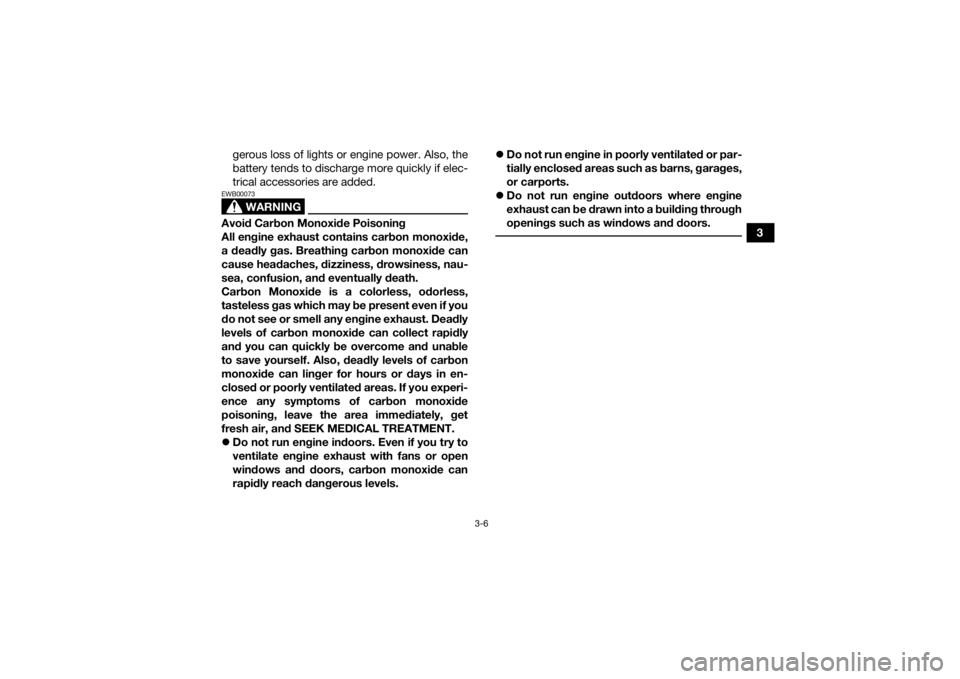
3-6
3
gerous loss of lights or engine power. Also, the
battery tends to discharge more quickly if elec-
trical accessories are added.
WARNING
EWB00073Avoid Carbon Monoxide Poisoning
All engine exhaust contains carbon monoxide,
a deadly gas. Breathing carbon monoxide can
cause headaches, dizziness, drowsiness, nau-
sea, confusion, and eventually death.
Carbon Monoxide is a colorless, odorless,
tasteless gas which may be present even if you
do not see or smell any engine exhaust. Deadly
levels of carbon monoxide can collect rapidly
and you can quickly be overcome and unable
to save yourself. Also, deadly levels of carbon
monoxide can linger for hours or days in en-
closed or poorly ventilated areas. If you experi-
ence any symptoms of carbon monoxide
poisoning, leave the area immediately, get
fresh air, and SEEK MEDICAL TREATMENT.
Do not run engine indoors. Even if you try to
ventilate engine exhaust with fans or open
windows and doors, carbon monoxide can
rapidly reach dangerous levels.
Do not run engine in poorly ventilated or par-
tially enclosed areas such as barns, garages,
or carports.
Do not run engine outdoors where engine
exhaust can be drawn into a building through
openings such as windows and doors.
UBLT60E0.book Page 6 Tuesday, July 13, 2021 9:16 AM
Page 31 of 176
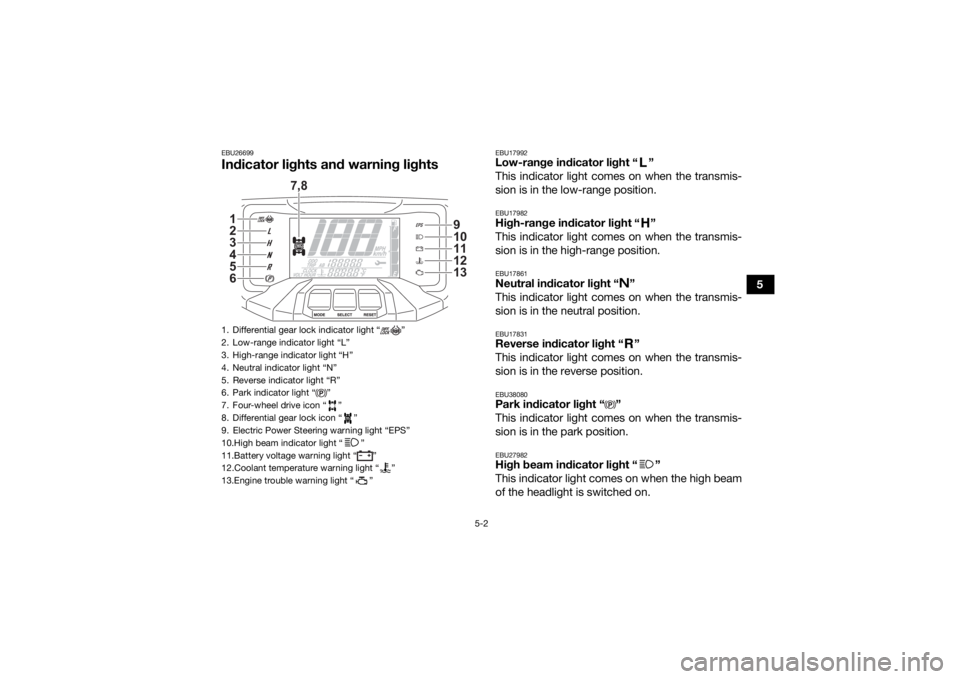
5-2
5
EBU26699Indicator lights and warning lights
EBU17992Low-range indicator light “ ”
This indicator light comes on when the transmis-
sion is in the low-range position.EBU17982High-range indicator light “ ”
This indicator light comes on when the transmis-
sion is in the high-range position.EBU17861Neutral indicator light “ ”
This indicator light comes on when the transmis-
sion is in the neutral position.EBU17831Reverse indicator light “ ”
This indicator light comes on when the transmis-
sion is in the reverse position.EBU38080Park indicator light “ ”
This indicator light comes on when the transmis-
sion is in the park position.EBU27982High beam indicator light “ ”
This indicator light comes on when the high beam
of the headlight is switched on.
1. Differential gear lock indicator light “ ”
2. Low-range indicator light “L”
3. High-range indicator light “H”
4. Neutral indicator light “N”
5. Reverse indicator light “R”
6. Park indicator light “ ”
7. Four-wheel drive icon “ ”
8. Differential gear lock icon “ ”
9. Electric Power Steering warning light “EPS”
10.High beam indicator light “ ”
11.Battery voltage warning light “ ”
12.Coolant temperature warning light “ ”
13.Engine trouble warning light “ ”1
7,8
23456
910111213
UBLT60E0.book Page 2 Tuesday, July 13, 2021 9:16 AM
Page 41 of 176
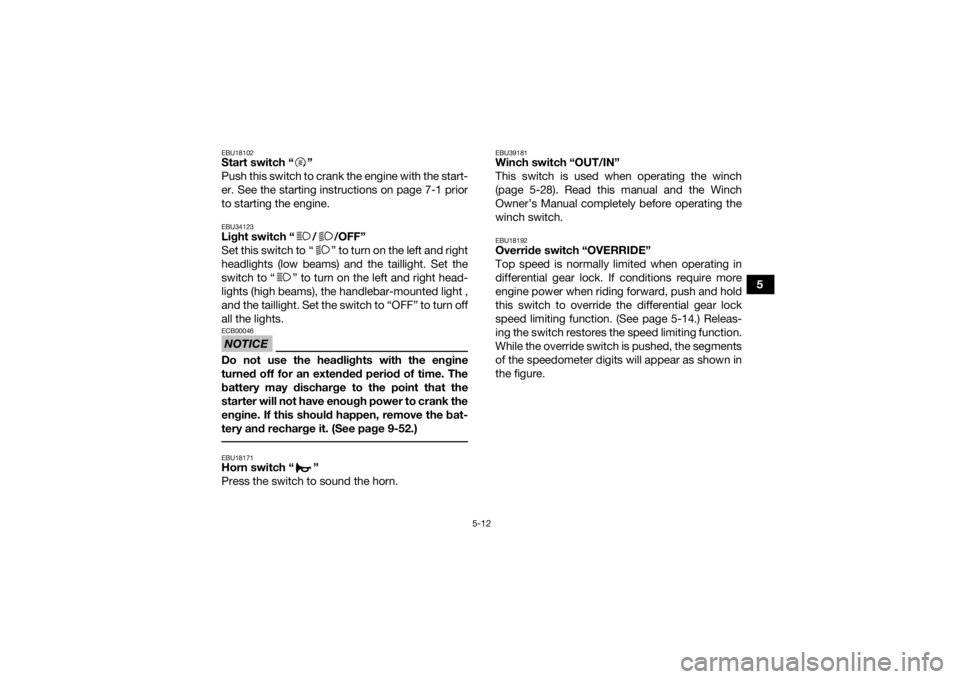
5-12
5
EBU18102Start switch “ ”
Push this switch to crank the engine with the start-
er. See the starting instructions on page 7-1 prior
to starting the engine.EBU34123Light switch “ / /OFF”
Set this switch to “ ” to turn on the left and right
headlights (low beams) and the taillight. Set the
switch to “ ” to turn on the left and right head-
lights (high beams), the handlebar-mounted light ,
and the taillight. Set the switch to “OFF” to turn off
all the lights.NOTICEECB00046Do not use the headlights with the engine
turned off for an extended period of time. The
battery may discharge to the point that the
starter will not have enough power to crank the
engine. If this should happen, remove the bat-
tery and recharge it. (See page 9-52.) EBU18171Horn switch “ ”
Press the switch to sound the horn.
EBU39181Winch switch “OUT/IN”
This switch is used when operating the winch
(page 5-28). Read this manual and the Winch
Owner’s Manual completely before operating the
winch switch.EBU18192Override switch “OVERRIDE”
Top speed is normally limited when operating in
differential gear lock. If conditions require more
engine power when riding forward, push and hold
this switch to override the differential gear lock
speed limiting function. (See page 5-14.) Releas-
ing the switch restores the speed limiting function.
While the override switch is pushed, the segments
of the speedometer digits will appear as shown in
the figure.
UBLT60E0.book Page 12 Tuesday, July 13, 2021 9:16 AM
Page 48 of 176
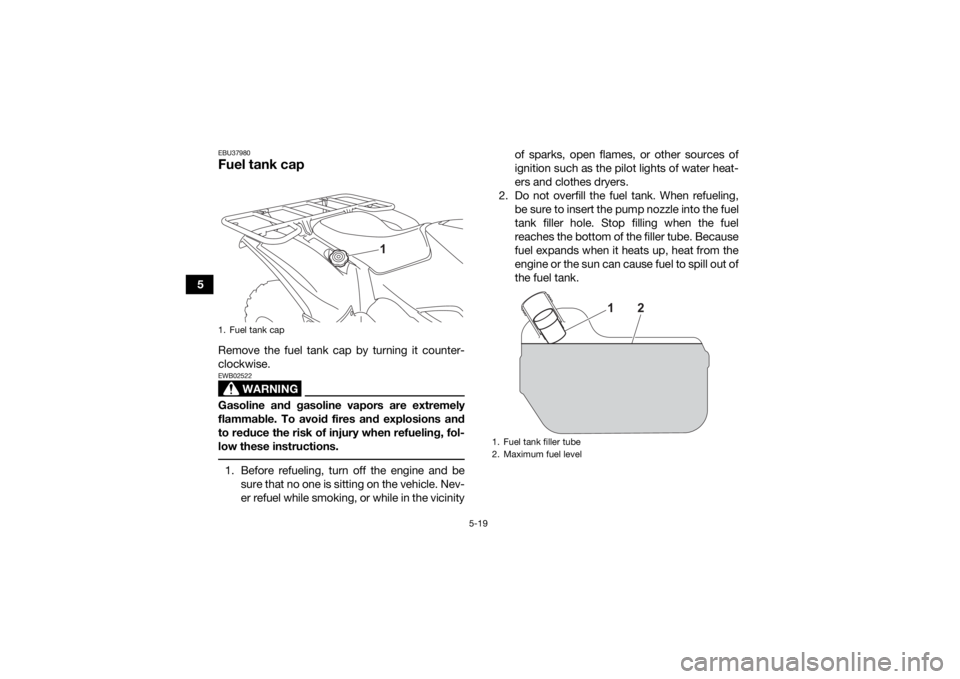
5-19
5
EBU37980Fuel tank capRemove the fuel tank cap by turning it counter-
clockwise.
WARNING
EWB02522Gasoline and gasoline vapors are extremely
flammable. To avoid fires and explosions and
to reduce the risk of injury when refueling, fol-
low these instructions. 1. Before refueling, turn off the engine and besure that no one is sitting on the vehicle. Nev-
er refuel while smoking, or while in the vicinity of sparks, open flames, or other sources of
ignition such as the pilot lights of water heat-
ers and clothes dryers.
2. Do not overfill the fuel tank. When refueling, be sure to insert the pump nozzle into the fuel
tank filler hole. Stop filling when the fuel
reaches the bottom of the filler tube. Because
fuel expands when it heats up, heat from the
engine or the sun can cause fuel to spill out of
the fuel tank.1. Fuel tank cap
1
1. Fuel tank filler tube
2. Maximum fuel level
2
1
UBLT60E0.book Page 19 Tuesday, July 13, 2021 9:16 AM
Page 59 of 176
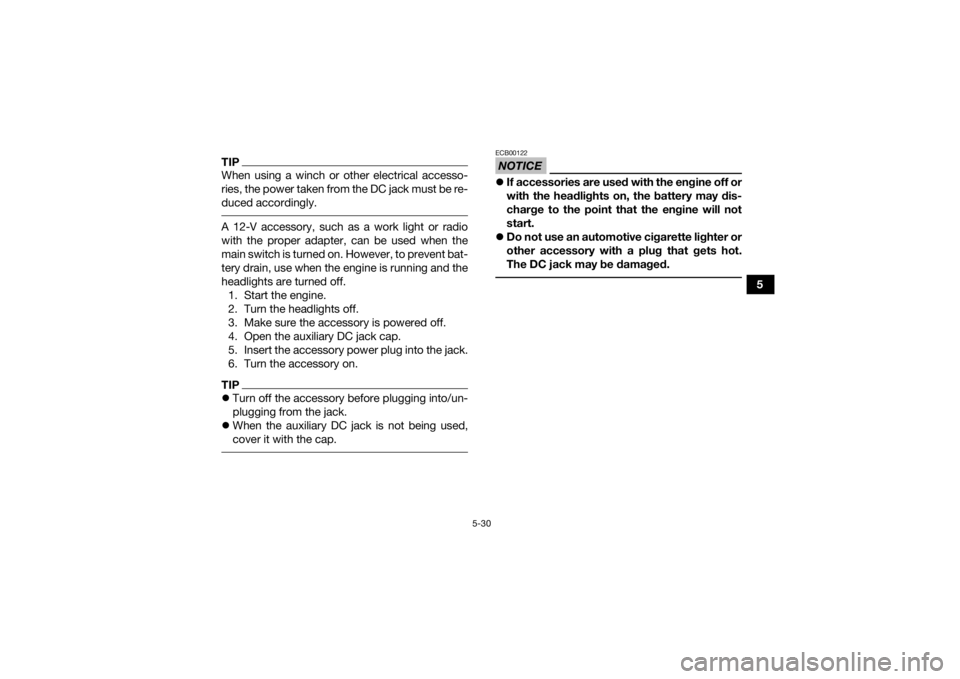
5-30
5
TIPWhen using a winch or other electrical accesso-
ries, the power taken from the DC jack must be re-
duced accordingly. A 12-V accessory, such as a work light or radio
with the proper adapter, can be used when the
main switch is turned on. However, to prevent bat-
tery drain, use when the engine is running and the
headlights are turned off.1. Start the engine.
2. Turn the headlights off.
3. Make sure the accessory is powered off.
4. Open the auxiliary DC jack cap.
5. Insert the accessory power plug into the jack.
6. Turn the accessory on.TIP Turn off the accessory before plugging into/un-
plugging from the jack.
When the auxiliary DC jack is not being used,
cover it with the cap.
NOTICEECB00122If accessories are used with the engine off or
with the headlights on, the battery may dis-
charge to the point that the engine will not
start.
Do not use an automotive cigarette lighter or
other accessory with a plug that gets hot.
The DC jack may be damaged.
UBLT60E0.book Page 30 Tuesday, July 13, 2021 9:16 AM
Page 61 of 176

6-2
6
Front brake• Check operation. If soft or spongy, have Yamaha dealer bleed hy-
draulic system.
• Check brake pads for wear, and replace if necessary.
• Check brake fluid level in reservoir, and add specified brake fluid to specified level if necessary.
• Check hydraulic system for leakage. Correct if necessary. 6-4, 9-43, 9-44, 9-46
Rear brake • Check operation. If soft or spongy, have Yamaha dealer bleed hy-
draulic system.
• Check pedal free play, and adjust if necessary.
• Check brake pads for wear, and replace if necessary.
• Check brake fluid level in reservoir, and add specified brake fluid to specified level if necessary.
• Check hydraulic system for leakage. Correct if necessary. 6-4, 9-43, 9-44, 9-46,
9-47
Throttle lever • Make sure that operation is smooth. Lubricate cable and lever
housing if necessary.
• Check lever free play, and adjust if necessary. 6-5, 9-42
Control cables • Make sure that operation is smooth. Lubricate if necessary. 9-49
Wheels and tires • Check wheel condition, and replace if damaged.
• Check tire condition and tread depth. Replace if necessary.
• Check air pressure. Correct if necessary. 6-5
Brake pedal • Make sure that operation is smooth. Lubricate pedal pivoting point
if necessary. 9-50
Brake levers • Make sure that operation is smooth. Lubricate lever pivoting points
if necessary. 9-49
Axle boots • Check for cracks or damage, and replace if necessary. 9-48
Chassis fasteners • Make sure that all nuts, bolts and screws are properly tightened. 6-8
Instruments, lights and
switches • Check operation, and correct if necessary.
6-8
ITEM
ROUTINE PAGE
UBLT60E0.book Page 2 Tuesday, July 13, 2021 9:16 AM
Page 67 of 176

6-8
6
Aftermarket tires and rims
The tires and rims that came with your ATV were
designed to match the performance capabilities
and to provide the best combination of handling,
braking, and comfort. Other tires, rims, sizes, and
combinations may not be appropriate.
EBU19841Chassis fastenersMake sure that all nuts, bolts and screws are
properly tightened.EBU19851Instruments, lights and switchesCheck that all instruments, lights and switches are
working properly. Correct if necessary.
Front:
Manufacturer/model:MAXXIS/MU01Y (BLTE)
MAXXIS/MU05Y (BLT5, BLT8)
Size: AT26 x 8-12 (BLT5, BLT8)
AT27 x 10-14 (BLTE)
Rear: Manufacturer/model:MAXXIS/MU01Y (BLTE)
MAXXIS/MU06Y (BLT5, BLT8)
Size: AT26 x 10-12 (BLT5, BLT8)
AT27 x 10-14 (BLTE)
Maximum tire seating pressure: Front250 kPa (2.5 kgf/cm², 36 psi)
Rear 250 kPa (2.5 kgf/cm², 36 psi)
UBLT60E0.book Page 8 Tuesday, July 13, 2021 9:16 AM